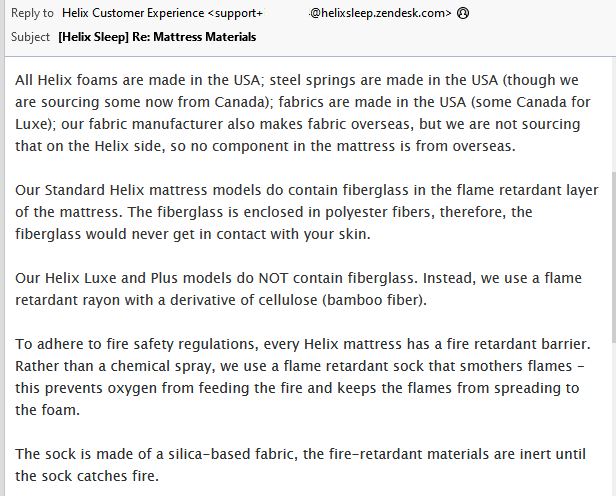Fiberglass has been a big deal in the mattress industry for a few years. Mattress manufacturers were using fiberglass as a means cheap flame-resistant material to meet flammability tests. It seemed to be fine at first, but over time the mattresses were damaged or broke down over time and the fiberglass started leaking out.
At first, mattress makers were pretty apathetic about their fiberglass being released and potentially causing health issues to consumers. However, a few big-name mattress makers were eventually blasted on YouTube, in the news, and actually had lawsuits filed against them. That’s when finding fiberglass free mattresses started being a focus for most shoppers.
So, does HELIX use fiberglass in their mattresses? No, Helix mattresses are fiberglass-free, but a few years back they did contain fiberglass.
Does it Matter if HELIX uses Fiberglass?
Yes, fiberglass in mattresses is definitely a concern. While fiberglass is definitely a cheap flame-resistant to pass flammability tests, it’s definitely not the safest option. Mattresses with fiberglass are fine at first, but over time the fiberglass breaks down into small shards and makes its way outside the mattress. Tears or rips accidentally put in fiberglass-containing mattresses can speed up the fiberglass leaking process.
Fiberglass can easily be identified by making the room dark and shining a flashlight around the mattress to see if the glass shards sparkle. If the mattress is on a platform, it’s a good idea to shine the light under the bed to see if glass shards are making their way out the bottom.
The problem with fiberglass leaking from a mattress is pretty obvious to most. Fiberglass is just thin glass mixed with resin, and when touched it causes skin irritation. That’s why you’re not supposed to touch that pink fiberglass insulation found in walls and attics. It can also cause irritation of the mucous membranes if inhaled, meaning nose and throat irritation, plus it’s definitely not great for your eyes.
Some of the most unlucky of the fiberglass mattress owners on YouTube and in the news didn’t notice the fiberglass leaking from their mattress until after their entire wardrobe of clothes had been contaminated with itchy fiberglass.
How are HELIX Mattresses Constructed?
HELIX Makes 6 different mattresses that each come in “Standard” 4 layer setup or a “Luxe” 6 layer configuration for a total of 12 different mattresses. HELIX recommends 6 for Side Sleepers, and the other 6 for Stomach and Back sleepers. Some HELIX mattresses have gel-infused cooling memory foam, some don’t. All HELIX mattresses have the option of upgrading to a GlacioTex Cooling Cover, made from a 50/50 blend of polyester and polyethylene, instead of the standard cover made from either polyester or TENCEL (rayon). Here’s a breakdown of how all the HELIX mattresses are constructed.
HELIX Mattress Construction Summary:
- DuraDense Foam – All HELIX mattresses start with a thin layer of High-Density foam to support the coils.
- Wrapped Coils – Next up on HELIX mattresses are individually wrapped coils on top of the dense foam.
- High-Grade Support Polyfoam or Memory foam – On top of the coils is a layer of support polyfoam or copper-infused Memory Foam.
- High-Grade Soft Polyfoam or Gel Memory Foam – Next up on “Luxe” and “Plus” models of HELIX mattresses is a Soft Polyfoam or Gel-infused Memory Foam.
- Contouring Foam – The last foam layer on a HELIX mattress is soft contouring polyfoam or a synthetic latex hybrid.
- Standard or GlacioTex Cooling Cover – The standard covers of HELIX mattresses are a soft Polyester cover or a breathable TENCEL depending on the model, but they all have the option to be upgraded to a blend of polyester and polyethylene that HELIX calls their GlacioTex Cooling Cover. Between these covers and the last foam layer is a firesock made from bamboo-derived rayon.
It’s True, HELIX used Fiberglass a Few Years Ago
When I originally contacted HELIX about fiberglass use back in 2020, they admitted the use of fiberglass in their mattresses. HELIX stated that all of its “Standard” mattress options use fiberglass and that the fiberglass was woven within the polyester flame-resistant barrier of the mattresses.

So, Does HELIX have Fiberglass Now?
The HELIX glossary states this, “Fiberglass had traditionally been used to provide fire retardancy in mattresses but can be dangerous if exposed. At Helix, we do not use fiberglass in any mattress model.”

Also, the HELIX FAQ page was updated 2 months ago to state, “No, every Helix mattress is made without the use of fiberglass. All Helix mattresses are designed with a fire retardant yarn made from rayon, a derivative of cellulose (bamboo fiber).”

Actual Conversation with HELIX Sleep
I contacted HELIX and asked this question:
“Back in 2020 I asked Helix about fiberglass and was told that the standard lines of mattresses contain fiberglass. However, your glossary and FAQ page both now state that there is no fiberglass in any Helix mattresses. Is this true?”
This is the reply I received from HELIX:
“That’s correct! We now make all of our mattresses without any fiberglass whatsoever.” -Felicia
Last Updated on April 18, 2024

While shopping for his daughter’s first “big girl” bed in 2019, John learned about the hidden dangers of fiberglass in mattresses. Since then, he’s made it his mission to expose as much hidden fiberglass in mattresses as possible. His ultimate goal is federal regulations that ban fiberglass from being used in mattresses, or at least a law that requires it to be listed as a material on required tags.
